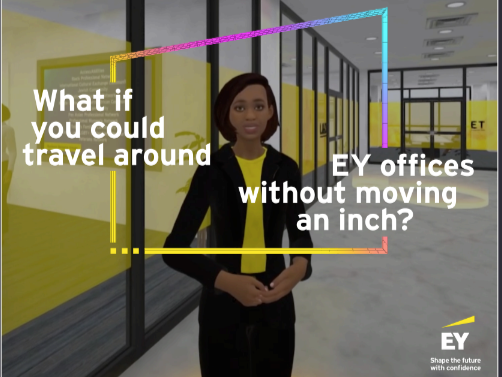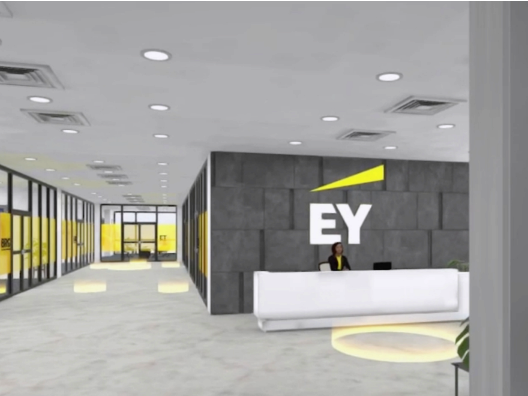How EY reinvented recruitment and onboarding with AI and the metaverse
Creating new comms channels with generative tech.

As the AI hype cycle reaches its peak, we’ve already explored the urgent need for personalized upskilling, along with the importance of documenting productivity gains to make the AI budget case.
Less discussed are the new communications channels that this technology will create.
“If harnessed the right way, generative technologies could create a whole host of new channels for communicators,” said Meredith Shue, director of internal communications strategy, talent brand, and innovation for EY Americas.
Domhnaill Hernon, global lead of EY’s Metaverse Lab, echoes Shue’s sentiment.
“Gen AI is pervasive in everything we do,” he explained. “From the start of every project to the end of every project, we’re leveraging AI and Gen AI in different ways.”
Shue and Hernon are at the forefront of EY’s efforts to transform the recruitment, interview and onboarding process using AI and the metaverse. They spoke with Ragan about what’s new, what’s on the horizon, and how this augments the employee experience with comms at the center.
Reimagining interviews with AI
EY continuously reimagines its recruitment process using AI and the metaverse to offer fresh ways for the next generation of candidates to engage with the firm. Among these innovations is an AI-powered avatar named “eVe” that Shue described as “an interview coach that allows candidates to ask questions they might not feel comfortable asking in a real interview.”
“When you design these solutions the right way, people can feel much more comfortable interacting with an AI agent,” agreed Hernon, emphasizing that eVe not only alleviates anxiety but also provides candidates with a more personalized and low-pressure pre-interview experience.
“It reduces the social threat practically to zero,” he added. “And if it’s designed well, people will open up, interact and ask questions.”
This AI-driven interaction is especially meaningful to younger, digitally native candidates who can be more comfortable interacting in a gamified environment.
“We’re supporting people where they feel comfortable,” said Shue.
Rethinking recruitment and intern engagement in the metaverse
In addition to eVe, EY is also mapping its office spaces in the metaverse to stand out with its recruitment efforts. This involves creating “digital twins” of its offices, and then allowing students to explore those spaces during campus job fairs using virtual reality headsets.
“We’ve scanned two floors of 12 offices across the country, and now students can walk through the office nearest to their campus, experiencing our culture and learning about what we do,” Shue said.

This effort is a tangible example of that old “meet people where they are” aphorism that’s central to communicating a meaningful employee experience—and EY’s commitment to innovation.
“We use Gen AI to create thousands of potential 3D environments, which helps us lock in alignment with stakeholders from day one,” Hernon said. This ensures that the virtual spaces EY builds are tailored to the functions of candidates and business leaders, providing personalized and interactive touchpoints for candidates that can also be used to bring dispersed colleagues closer together.
Innovating internships
EY also deploys its metaverse build with its intern program.
“We created a Metaverse environment, called the WeVerse, where we could bring our interns in,” said Shue. “They played games, engaged in group exercises, and explored their personal purpose statements.” Applying the tech this way centered a digital-first approach around EY’s culture of connection.
The emotional impact of these immersive experiences cannot be overstated. Shue remembers one intern who shared that they overcame imposter syndrome by engaging in the EY metaverse.
“They felt more comfortable and confident after going through the growth mindset content and the interactive game,” she said. For Hernon, this win emphasizes how EY’s investments in AI and immersive tech allow the firm to “bring our culture and values to life in a way that’s not possible with traditional tools.”
How comms and tech teams work together
The greatest barrier to pushing your business further along the AI maturity curve may not be budget, but collaboration across teams. At EY, close collaboration between technology, talent and communications teams allows AI to be integrated into the beginning of each project.
“We have the executive sponsor, the technology leader, talent team members and the Brand, Marketing and Communications team all working together from day one,” said Hernon, explaining how an integrated BMC function embeds those leaders across each major part of the business.
This ensures that onboarding solutions are not only technologically scalable, but also aligned with business goals and communication strategies.
“Every single decision we make, every investment, is made through the lens of the use case,” Hernon added. “It’s not about tech first and then we market it as an afterthought or go to a change communications plan. All of that is considered from the very first moment in time, and we launch in a way that almost guarantees success because we’ve strategized and road-mapped all those dimensions of importance from day one.”
Positioning AI as an augmentation tool
Both Shue and Hernon positioned these innovations as an augmentation tool.
“This is not about replacing jobs,” Hernon explained. “It’s about creating tools that augment people’s work and help them do their jobs better.” Shue agreed, emphasizing the important role that internal communications leads play in positioning these tools as a support instead of a substitute.
Hernon believes that taking an engagement-first approach to scaling tech is about more than messaging— it’s critical for the success of any AI-powered initiative.
“Before we launch anything, we make sure there’s a clear understanding of how it will benefit our people and candidates,” he said. Getting that alignment upfront builds trust.
Collaborative innovation positions comms as a driver of business
By embedding AI and metaverse tech in the employee lifecycle, EY created new channels for communicators to capture candidate and employee sentiment. By normalizing collaboration between comms and tech leads to make these initiatives happen, the firm also centered the communications function in the story of its business innovation and growth.
“We’re transforming communications to be a real driver of business,” said Shue.
She believes that sharing the success of these innovations with EY’s internal stakeholders, before taking them to market, is proof of the function’s influence.
“We can create and commercialize this work, but when we’ve done it for our people first, that case study is comms on a whole other level.”
Shue and Hernon will showcase this innovative approach at Ragan’s AI Horizons Conference in Miami Beach next February. Register now.
EY is a member of Ragan’s Communications Leadership Council. Learn more about joining here.
Justin Joffe is the editorial director and editor-in-chief at Ragan Communications. Follow him on LinkedIn.








I am fascinated by how EY is using AI and the metaverse to transform recruitment and onboarding processes. The use of “eVe,” an AI-powered avatar, as an interview coach is an excellent technique to reduce candidate nervousness and create a more comfortable setting.
Furthermore, the introduction of virtual reality to allow applicants to view office premises and participate in immersive activities fundamentally changes how we interact with potential hiring. It’s great to see technology used not just as a tool, but also to improve the work experience and develop meaningful connections.
This unique approach clearly demonstrates the promise of AI in HR—not as a replacement for human connection, but as an augmentation that can bring our values and culture to life in new ways.